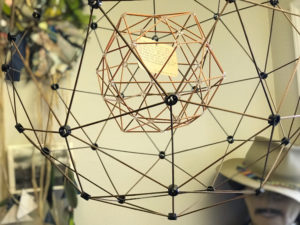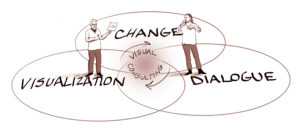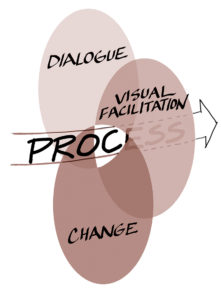Visual Consulting: Co-Creating the Future

For years I’ve had an open geodesic sphere hanging in my studio with two quotes hanging in the middle. One is by Buckminster Fuller, inventor of geodesics. To paraphrase, he says you can’t reform humans where they are (I think he said “man,” dating him). The best you can do, he continues, is to go into the outlaw area and make it so attractive that people eventually copy you.
On the opposite side of the card is this quote by W. Warren Wagar, historian: “The ultimate function of prophecy is not so much to foretell the future as to shape it.”
As Gisela Wendling and I sit midway through co-creating the fourth book in the Wiley Visual Leadership series, called Visual Consulting: Designing & Leading Change, I find these quotes even more relevant. I know that people like tools and want practical things to do in these kinds of books. But Gisela and I also care about a future that can reclaim other elements that seem to be neglected in our increasingly high tech, maximization-oriented society—such as feelings, deep listening, trusting one’s trained intuition, and having a spiritual practice that keeps us grounded in a time of growing chaos.
So we are writing about a future we hope to shape, one where the utility and excitement of visual facilitation can integrate with what practitioners are learning about the importance of dialogue, as well as with the practices emerging from a growing field of change consultants.
We started out leaning into the visual side, for obvious reasons—it’s been my professional life for more than 40 years. We titled our first chapter “The ABC’s of Visual Consulting” and began to organize our thinking around “awareness,” “big picture thinking,” and “collaboration.” We built this out, but the structure was artificial and collapsed. We aren’t really about creating ABCs in a new medium, but about something more challenging.
 Simultaneously, our colleague Alan Briskin has been writing about “fields.” He’s going back to Teilhard de Chardin, David Bohm, Rupert Sheldrake, Carl Jung, and Irving Lazlo to see how they wrestled with describing and writing about the underlying, implicate order that many believe cuts across all the apparent fragmentation. Gisela and I began to realize that we were actually writing out of our deep familiarity with three fields of practice that we are integrating.
Simultaneously, our colleague Alan Briskin has been writing about “fields.” He’s going back to Teilhard de Chardin, David Bohm, Rupert Sheldrake, Carl Jung, and Irving Lazlo to see how they wrestled with describing and writing about the underlying, implicate order that many believe cuts across all the apparent fragmentation. Gisela and I began to realize that we were actually writing out of our deep familiarity with three fields of practice that we are integrating.
Visual practice as reflected by the International Forum of Visual Practitioners seems to be exploding, especially in Europe. Illustrators and designers are coming in at a steady pace. While the visual are increasingly eye-popping, many designers have little or no group process experience. This is of concern to those of us who deeply understand that it is group engagement, relationship and conversation that create new social realities—not better artifacts. At the same time, the vitality and enthusiasm of the new practitioners is exceptional and hopeful.
Dialogue as a field has been developing all along in the field of organization development, with support from Peter Senge and the Society for Organizational Learning. This field has expanded, as Gervase Bushe and Robert Marshak’s book Dialogic OD, The Theory and Practice of Transformational Change brilliantly argues. If social construction is a primary force in shaping the core narratives that guide behavior and action in organizations, then dialogue practices have to be included.

The field of change work is evolving as well. In the late 1990’s large consulting firms began absorbing OD firms and process consultants to help with “change management,” the term that was preferred. The Association of Change Management Professionals is growing quite quickly, fueled by internal consultants charged with “making it so” on big institutional changes. The field ranges from the tool-oriented work of organizations like Prosci to transformation-change-oriented approaches such as Thomas Hübl and Bill Uri’s Meditate and Mediate on-line course, insisting that inner mindfulness development is essential in conflict resolution and mediation.
It’s a challenge to think and write into a cross-disciplinary vision, but Gisela and I think that it is process awareness and process leadership that unite and flow through these fields. The Grove’s work with Arthur M. Young’s Theory of Process is deep and has, of course, informed this perception.
Our hope is to shape a future that is more integrated, appreciative, and respectful of differences, where visual consultants can help lead clients in the development of cultures of collaboration and innovation as we face the numbing changes of our time. And we love living here in the “outlaw” area of the West Coast, up in the redwoods, close to the wide and mysterious Pacific Ocean, whose waters cover nearly half the globe. Stay tuned.


Eukene Barrenetxea
February 9, 2018Hi David,
Something as big as the Team Performance Model is being created here, I guess. It,s so deep, smart and beautiful.
Thanks for inspiring US.
Best regards,
Eukene
Eukene Barrenetxea
February 9, 2018Hi David,
Something as big as the Team Performance Model is being created here, I guess. It,s so deep, smart and beautiful.
Thanks for inspiring US.
Best regards,
Eukene
Eukene Barrenetxea
February 9, 2018Hi David,
Something as big as the Team Performance Model is being created here, I guess. It,s so deep, smart and beautiful.
Thanks for inspiring US.
Best regards,
Eukene